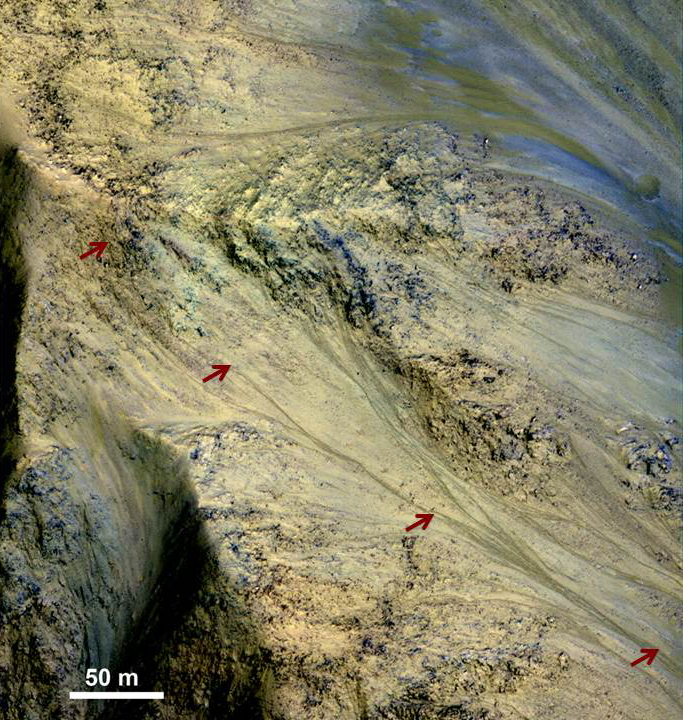
Mars' bizarre dark streaks may not be so astrobiologically intriguing after all.
Those streaks, known as recurring slope lineae, were discovered in 2011 by scientists studying imagery captured by the powerful High Resolution Imaging Experiment (HiRISE) camera aboard NASA's Mars Reconnaissance Orbiter (MRO).
As their name suggests, recurring slope lineae, or RSL for short, are found on Red Planet slopes. The marks creep down steep inclines, especially in Mars' southern hemisphere, during warm times of the year and fade away as the weather cools.
Photos: The search for water on Mars
These characteristics led scientists to speculate that the dark marks could be caused by salty liquid water flowing or seeping through the red dirt, in spots that get warm enough for some of Mars' plentiful subsurface ice to melt. That exciting hypothesis got a boost in 2015, when data gathered by MRO's Compact Reconnaissance Imaging Spectrometer instrument, or CRISM, revealed the apparent signature of hydrated salts at some RSL locales. That's just what you'd expect to see after briny liquid had evaporated away.
But the liquid-water explanation has been losing favor over the last few years. For example, a 2018 study cast serious doubt on the CRISM find, suggesting that the supposed hydrated-salt fingerprint was actually an artifact of data processing. And researchers have been finding more and more evidence, from both experimental and modeling work, that dry landslides are etching the dark marks into warm Martian slopes.
Another such study came out this past January. HiRISE imagery revealed a big increase in RSL activity in the wake of the global dust storm that killed NASA's Opportunity Mars rover in 2018, researchers report in the paper, which was published in Journal of Geophysical Research: Planets.
Get the Space.com Newsletter
Breaking space news, the latest updates on rocket launches, skywatching events and more!
The team, led by HiRISE principal investigator Alfred McEwen, counted 150 active RSL sites during the year of the dust storm, compared to an annual average of just 36 in the six previous years. (The years here are Mars years, each of which lasts about 687 Earth days.)
"There are clear dust devil tracks in 73% of post‐storm images in the southern middle latitudes in the summer, where and when dust devils are most active," the researchers wrote in the study.
"The tracks indicate dust lifting, by several mechanisms," they added. "We suggest that dust lifting processes on steep slopes may initiate and sustain RSL formed from flows of dust (perhaps clumped) and/or sand that is destabilized by dust movement."
McEwen discussed the recent study last Thursday (March 25) during a presentation at the 2021 Spring Meeting of the U.S. National Academies of Sciences, Engineering and Medicine's Committee on Planetary Protection. (Planetary protection refers to efforts to avoid contaminating other worlds with microbes from Earth, and to prevent potential alien bugs from getting a foothold on our planet.)
He also gave an overview of the decade-long history of RSL research, which he said now points strongly toward dry explanations for the dark features.
"None of the wet hypotheses have survived, in my opinion," said McEwen, who's based at the University of Arizona's Lunar and Planetary Laboratory.
He also said he doesn't believe that RSL sites should be regarded as "special regions" — locales that might be capable of supporting Earth life and are therefore off-limits to exploration by all but the most rigorously sterilized spacecraft.
If that view becomes the consensus, it will be easier for NASA and other space agencies to send rovers to RSL sites and study the mysterious features up close. But consensus has not yet been reached; the new study, while suggestive, doesn't slam the door on the wet-RSL hypothesis.
"These debates will continue," McEwen said.
Mike Wall is the author of "Out There" (Grand Central Publishing, 2018; illustrated by Karl Tate), a book about the search for alien life. Follow him on Twitter @michaeldwall. Follow us on Twitter @Spacedotcom or Facebook.
Join our Space Forums to keep talking space on the latest missions, night sky and more! And if you have a news tip, correction or comment, let us know at: community@space.com.

Michael Wall is a Senior Space Writer with Space.com and joined the team in 2010. He primarily covers exoplanets, spaceflight and military space, but has been known to dabble in the space art beat. His book about the search for alien life, "Out There," was published on Nov. 13, 2018. Before becoming a science writer, Michael worked as a herpetologist and wildlife biologist. He has a Ph.D. in evolutionary biology from the University of Sydney, Australia, a bachelor's degree from the University of Arizona, and a graduate certificate in science writing from the University of California, Santa Cruz. To find out what his latest project is, you can follow Michael on Twitter.









